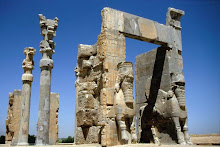
It is commonly accepted that Cyrus the Great was buried at Pasargadae. If there is any truth in the statement that the body of Cambyses II was brought home "to the Persians", his burying-place must be sought somewhere beside that of his father. Ctesias assumes that it was the custom for a king to prepare his own tomb during his lifetime. Hence the kings buried at Naghsh-e Rustam are probably Darius the Great, Xerxes I, Artaxerxes I and Darius II. Xerxes II, who reigned for a very short time, could scarcely have obtained so splendid a monument, and still less could the usurper Sogdianus (Secydianus). The two completed graves behind Takhti Jamshid would then belong to Artaxerxes II and Artaxerxes III. The unfinished one is perhaps that of Arses of Persia, who reigned at the longest two years, or, if not his, then that of Darius III (Codomannus), who is one of those whose bodies are said to have been brought "to the Persians."
Another small group of ruins in the same style is found at the village of Hajjiäbäd, on the Pulwar, a good hour's walk above Takhti Jamshid. These formed a single building, which was still intact 900 years ago, and was used as the mosque of the then existing city of Istakhr.
Since Cyrus the great was buried in Pasargadae, which is mentioned by Ctesias as his own city, and since, to judge from the inscriptions, the buildings of Persepolis commenced with Darius I, it was probably under this king, with whom the sceptre passed to a new branch of the royal house, that Persepolis became the capital of Persia proper. As a residence, however, for the rulers of the empire, a remote place in a difficult alpine region was far from convenient, and the real capitals were Susa, Babylon and Ecbatana. This accounts for the fact that the Greeks were not acquainted with the city until it was taken and plundered by Alexander the Great.
It has been universally admitted that "the palaces" or "the palace" burned down by Alexander are those now in ruins at Takhti Jamshid. From Stolze's investigations it appears that at least one of these, the castle built by Xerxes, bears evident traces of having been destroyed by fire. The locality described by Diodorus after Cleitarchus corresponds in important particulars with Takhti Jamshid, for example, in being supported by the mountain on the east.
Another small group of ruins in the same style is found at the village of Hajjiäbäd, on the Pulwar, a good hour's walk above Takhti Jamshid. These formed a single building, which was still intact 900 years ago, and was used as the mosque of the then existing city of Istakhr.
Since Cyrus the great was buried in Pasargadae, which is mentioned by Ctesias as his own city, and since, to judge from the inscriptions, the buildings of Persepolis commenced with Darius I, it was probably under this king, with whom the sceptre passed to a new branch of the royal house, that Persepolis became the capital of Persia proper. As a residence, however, for the rulers of the empire, a remote place in a difficult alpine region was far from convenient, and the real capitals were Susa, Babylon and Ecbatana. This accounts for the fact that the Greeks were not acquainted with the city until it was taken and plundered by Alexander the Great.
It has been universally admitted that "the palaces" or "the palace" burned down by Alexander are those now in ruins at Takhti Jamshid. From Stolze's investigations it appears that at least one of these, the castle built by Xerxes, bears evident traces of having been destroyed by fire. The locality described by Diodorus after Cleitarchus corresponds in important particulars with Takhti Jamshid, for example, in being supported by the mountain on the east.







